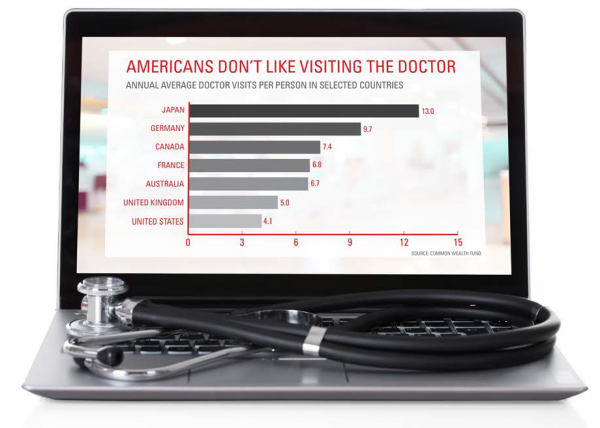CHALLENGES ENGAGING DIGITALLY
According to a Commonwealth Fund study, the average patient in the United States only visits the doctor four times a year. This limited frequency makes it critical for both healthcare provider organizations and health plans to engage with patients outside the traditional care setting in order to help them maintain their health and wellness.
Digital technologies such as mobile are critical for engaging and empowering patients outside the traditional medical setting. Mobile health app adoption has doubled in the last two years, but some healthcare organizations don’t have a mobile strategy or platform for their patients or members. Integrating mobile applications with enterprise systems is painstaking, and maintaining HIPAA compliance on mobile has proven to be difficult. Patients typically do not have access to all of their health data on-the-fly, and neither do providers. This makes it challenging for service providers to look at ways to provide custom-made services for specific members based on their lifestyle.
Mobile apps and devices can significantly improve engagement with patients and members. For example, Quest Diagnostics’ MyQuest™ mobile health app allows patients to view lab results on their mobile devices, thereby gaining valuable insights into their own health and having that information ready and accessible during health emergencies.
Healthcare consumers want to use mobile devices to connect with their plans and providers. In a survey by PricewaterhouseCoopers:
- 60% of patients are willing to have a video visit with a physician through a mobile device
- 88% of patients are willing to share personal data with their doctor to find new treatments
- 21% of patients have used a mobile device to refill a prescription
From the clinician perspective:
- 58% of clinicians would prefer to provide a portion of care virtually
- 81% of clinicians say mobile access to medical information helps coordinate patient care
APIs DRIVE PATIENT AND MEMBER ENGAGEMENT
There could not be a better time to leverage APIs to personalize healthcare. When a provider can integrate into an individual’s lifestyle, tracking things like what a member eats throughout the day or how often that person is working out, it’s much easier for healthcare to be designed as “custom built” plans for every member. This degree of personalization will prove to be a very symbiotic process that will help members embrace the changes in the healthcare industry with more open arms.
APIs have the capability to track member details using add-on devices like Fitbit, smart watches, and smart phones and then sync the daily data to a common data store, where analytics tools are used to create better plans and results for members. Instead of reading through an entire set of bio-data or health history for members, doctors can simply use the changes from previous visits to suggest better treatment plans, which makes it easier for both members as well as service providers.
Connected devices allow for interaction with members and patients across a range of devices – phone, tablet, apps, smart watches, etc. – and through channels that customers are now expecting. These touchpoints maintain engagement not only between consumers and plans or providers, but also between consumers and their own health.
Patient engagement is just one of the healthcare challenges mitigated by API management that we explore in our guide, Digitally Transforming Healthcare with APIs. Download the guide for the other ways APIs are changing healthcare and get real-world success stories from industry leaders.
